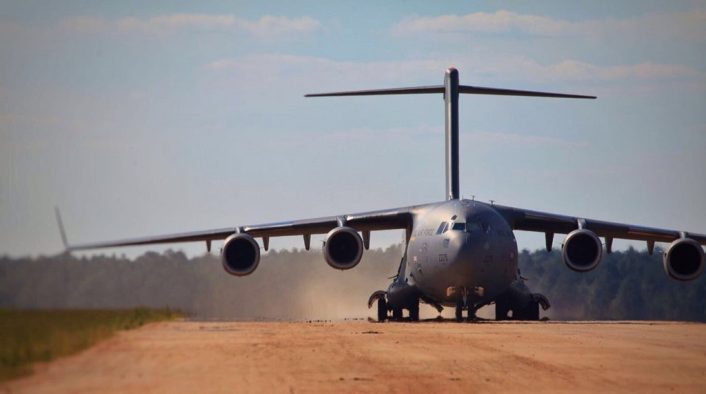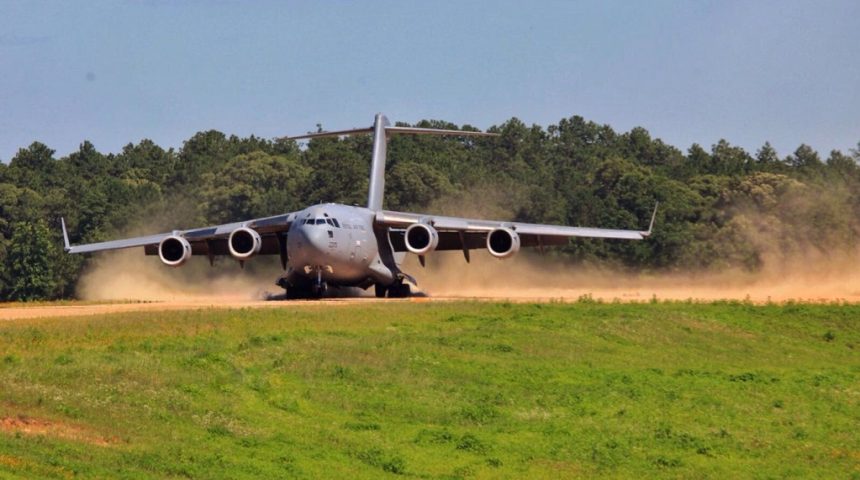The RAF is exploiting this capability of the C-17, already well known by the US Air Force, to further expand the flexibility of its fleet.
The Royal Air Force recently announced that a C-17 Globemaster III of 99 Squadron operated for the first time from an austere runway in Louisiana, United States. As mentioned in the press release, “the entire crew experienced first-hand the complexities of operating in this type of environment and learnt how best to prepare both aircraft and personnel to deliver safely, when called upon”.
Here’s a preview of what operating a C-17 on a dirt strip looks like, as we continue to develop our Semi Prepared Runway Operations capability ✈️🌾🪨
Find out more👇https://t.co/05yA7AVYmk#99Sqn #C17 #RAF #SPRO #SemiPreparedRunwayOperations #NoOrdinaryJob pic.twitter.com/x4hlkdezKr
— 99 Squadron RAF (@99Sqn) January 12, 2021
This training is part of the RAF’s effort to develop the aircraft’s Semi Prepared Runway Operations (SPRO) capability, a latent capability of the Globemaster which was never exploited by the UK, even if the aircraft has been in service since 2001. 99 Squadron, the only national C-17 fleet in Europe outside the NATO Strategic Airlift Capability (SAC), always used its eight aircraft only from paved runways, although they are certified to operate from austere and tactical locations which are normally not accessible to an aircraft of this size.
Number @99Sqn took the next step in developing the @RoyalAirForce C-17 Semi Prepared Runway Operations (SPRO) capability during training based in Louisiana, USA.
Read more: https://t.co/oyNaEUrrmq pic.twitter.com/YZAFDZjhVh
— RAF Brize Norton (@RAFBrizeNorton) January 8, 2021
The defence magazine Janes was able to obtain some more details, mentioning that the SPRO exercise took place at the Geronimo landing zone of the Joint Readiness Training Center at Fort Polk on December 26, and involved multiple landings and take offs from a dirt runway.
Since it entered service with the RAF, the C-17 Globemaster has been vital in maintaining the strategic lift capability to connect the UK and its deployed forces as well as humanitarian operations, complementing the tactical lift capability of the C-130J-30 Hercules C4 and, more recently, the A-400M Atlas C1 and the Voyager tanker. Despite already being certified to land during STOL operations (Short Take-Off and Landing) at a maximum weight of 265 tonnes on runways as short 3,500 feet, the British C-17s have always operated to well established airfields, restricting the flexibility of the transport component of the RAF.

SPRO involve operating from runways constructed from non-permanent materials, such as gravel, dirt or even packed ice and snow. This capability was included in the Globemaster’s design since the beginning, as it was built to carry outsized loads, which could not be carried by a C-130, to austere locations in an operational theater. The U.S. Air Force frequently practiced these operations in a training environment in locations like the Nevada Test & Training Range and the National Training Center at Fort Irwin (California), but they also used it during real operations like happened for example in Syria in 2018 and in 2019.
The goal of the RAF with the development of the C-17’s SPRO capability is to open a new area of operations for the UK Ministry of Defence, providing the nation with a greater flexibility to provide a rapid military response where needed, both in an armed conflict or during humanitarian aid operations anywhere in the world.
As a sidenote, the global C-17 fleet, which includes nine operators (USA, UK, UAE, Qatar, NATO, Kuwait, India, Canada and Australia), reached on January 15 the milestone of four million flight hours since the first Globemaster was delivered to the U.S. Air Force in 1993. The UK was the second country to receive the new aircraft and flown it for more than 140,000 hours.
Today, we celebrate the #C17 achieving the milestone of four million flying hours. The #Globemaster was delivered to @TeamCharleston in 1993 and the first operational C-17 squadron was established in 1995 pic.twitter.com/q3hAWxOnqI
— Air Mobility Command (@AirMobilityCmd) January 15, 2021
Today @usairforce celebrate the global C-17 fleet’s four millionth flight hour🥳
✈️
✈️
✈️ ✈️
✈️ ✈️✈️✈️
✈️
At 140,000 hours we have made up 3.5% of that with our @RoyalAirForce & @BoeingUK fleet! 🙌#99Sqn #C17 #RAF #USAF #ReadyAF pic.twitter.com/xiu3StBZXR
— 99 Squadron RAF (@99Sqn) January 15, 2021









